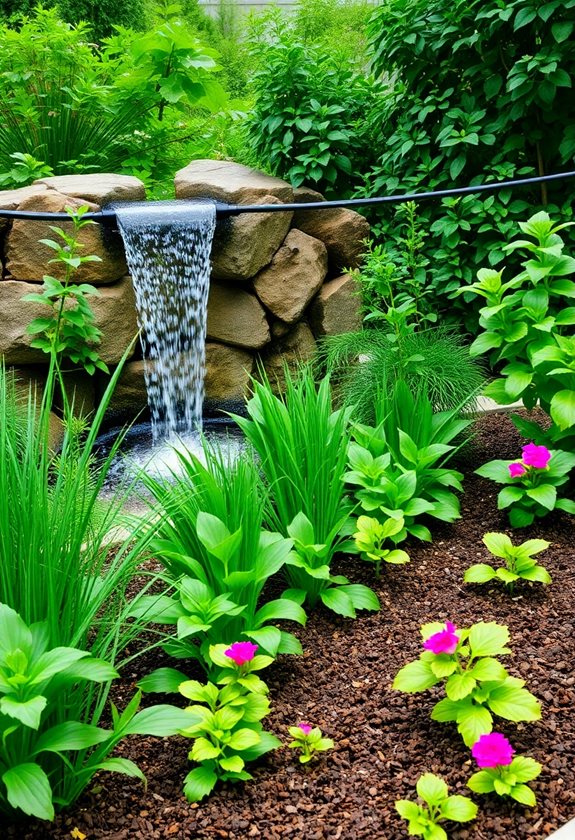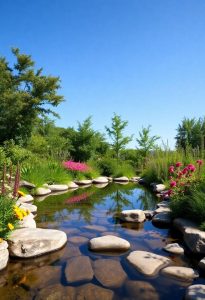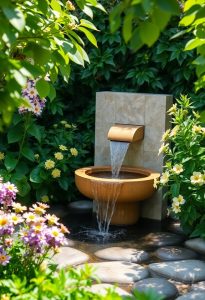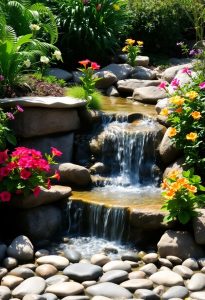To use water efficiently in your garden, try drip irrigation to target those thirsty roots, or set up a rain barrel to capture precious rainwater—every drop counts! Consider drought-resistant plants like succulents; they’re low-maintenance and thrive on less water. Keep your soil healthy by adding organic matter, and don’t forget to mulch—2-3 inches work wonders for moisture retention. Believe me, these simple tips can transform your garden! Want to know more fantastic ideas?
Design Highlights
- Implement drip irrigation systems to deliver water directly to plant roots, minimizing waste and maximizing efficiency.
- Capture rainwater using barrels to store water for garden use, reducing water bills and promoting sustainability.
- Choose drought-resistant and native plants that require less water and thrive in your local climate.
- Improve soil with organic matter to enhance moisture retention and allow for better water absorption.
- Use mulch and ground covers to suppress weeds and reduce evaporation, helping to maintain soil moisture.
Efficient Irrigation Techniques
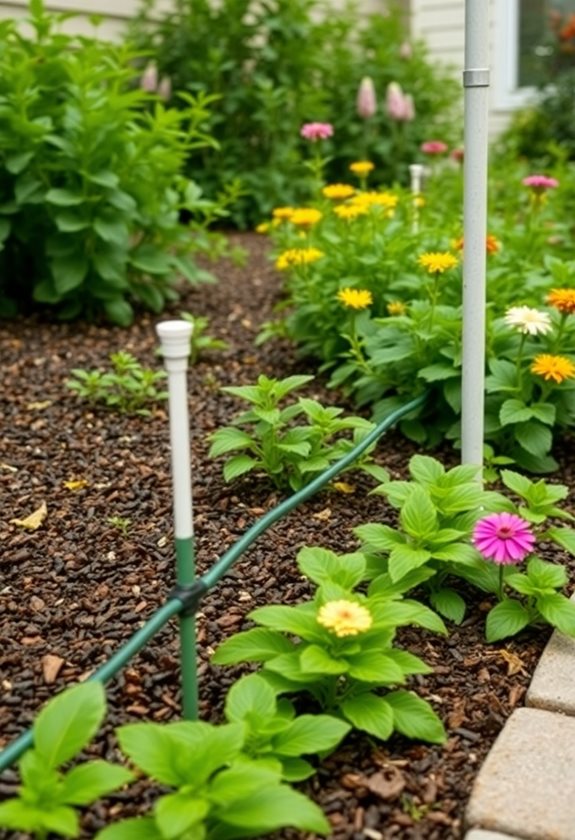
When you’re knee-deep in garden planning, have you ever found yourself wondering how to keep your plants happy without drowning them? Efficient irrigation techniques can be your best friends! You might consider drip irrigation systems, which deliver water directly to the roots, minimizing waste. Have you tried soaker hoses? They’re a simple way to keep moisture consistent. Another option is scheduling your watering in the early morning or late evening—this reduces evaporation. Remember, plants love a good soak, but not a swim! Experiment with these methods, and you’ll soon find the perfect balance for your garden’s thirsty roots! Additionally, incorporating drought-resistant plants can further enhance your garden’s resilience and reduce water needs.
Rainwater Harvesting Systems
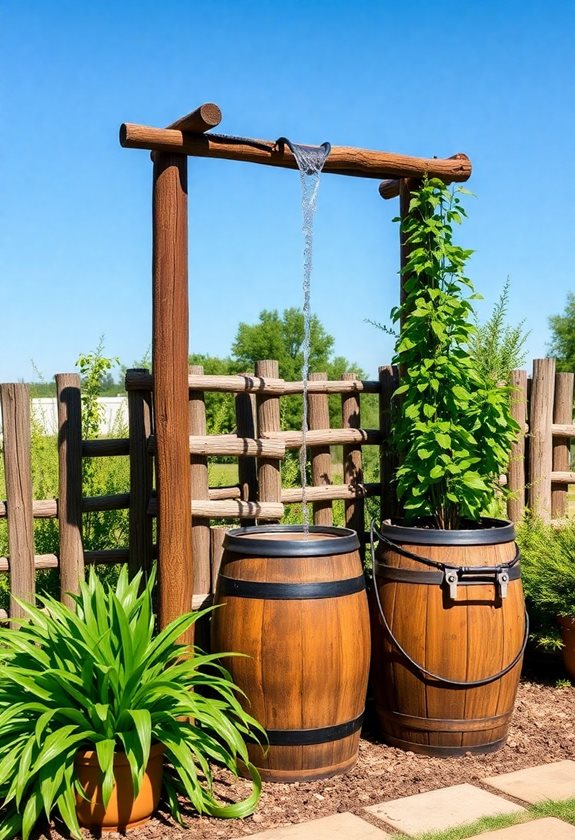
Imagine stepping outside after a rejuvenating rain, only to realize that all that precious water just disappears into the ground, never to be seen again! Why not catch that liquid gold with a rainwater harvesting system? It’s simpler than you think! Start by installing a rain barrel at your downspout. You can also connect multiple barrels for larger storage. This captured water is perfect for watering your garden, washing tools, or even filling bird baths. Remember, every drop counts! Plus, you’ll reduce your water bill. Additionally, using garden waterfalls can create a serene atmosphere while utilizing rainwater effectively. So, are you ready to turn that rain into a resource? Let’s get started!
Selecting Drought-Resistant Plants
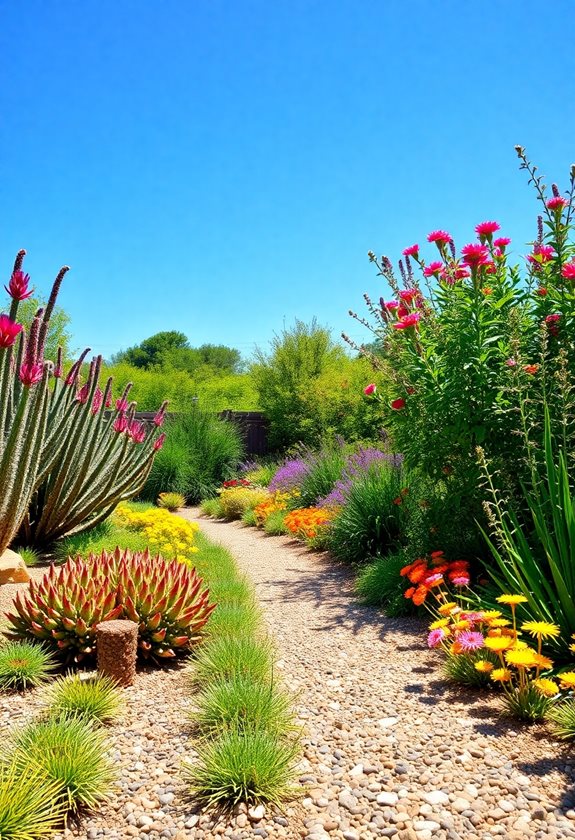
Choosing drought-resistant plants can feel like a game-changer for your garden, especially if you’re tired of constantly worrying about watering schedules. Imagine vibrant blooms that thrive without constant care! Look for native species—they’ve adapted to your climate and require less water. Think succulents, lavender, and ornamental grasses. Ever considered xeriscaping? It’s not just practical; it’s beautiful!
When selecting, check for deep root systems, which help them access moisture. Plus, group plants with similar water needs together. You’ll save time and effort! So, are you ready to transform your garden into a low-maintenance oasis? Let’s dig in! Additionally, incorporating drought-tolerant flowers can enhance the aesthetic appeal of your garden while minimizing water usage.
Soil Management for Water Retention
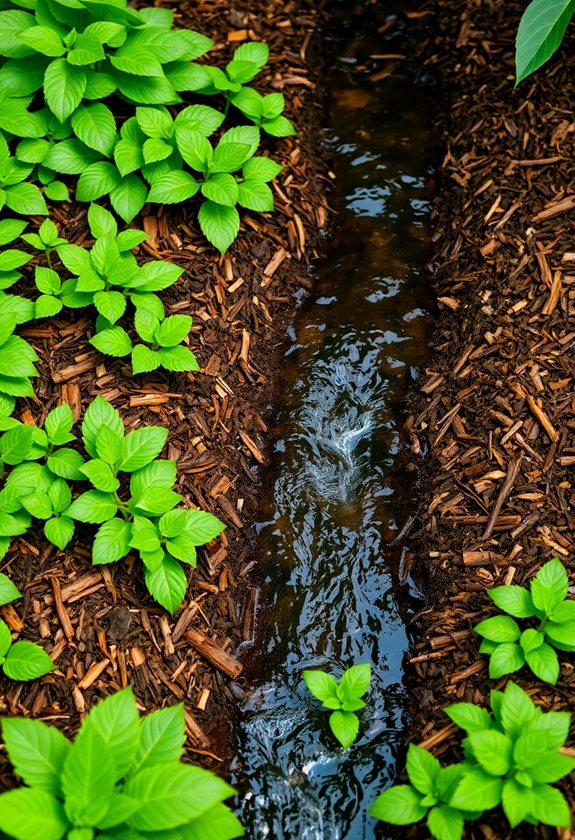
So, you’ve got your drought-resistant plants picked out, and now it’s time to think about how to keep that precious moisture in the ground where it belongs. Start by improving your soil structure—mix in organic matter like compost to enhance its water-holding capacity. Have you tried using clay or silt? They’re great at retaining moisture! Additionally, consider soil testing to check pH levels; balanced soil aids root health. And don’t forget to aerate—this allows water to penetrate deeper. Remember, happy soil means happy plants! To ensure your garden remains low-maintenance, it’s wise to avoid high-maintenance plants. Isn’t it satisfying to nurture your garden with thoughtful soil management? Let’s keep that moisture flowing!
Mulching and Ground Cover Strategies
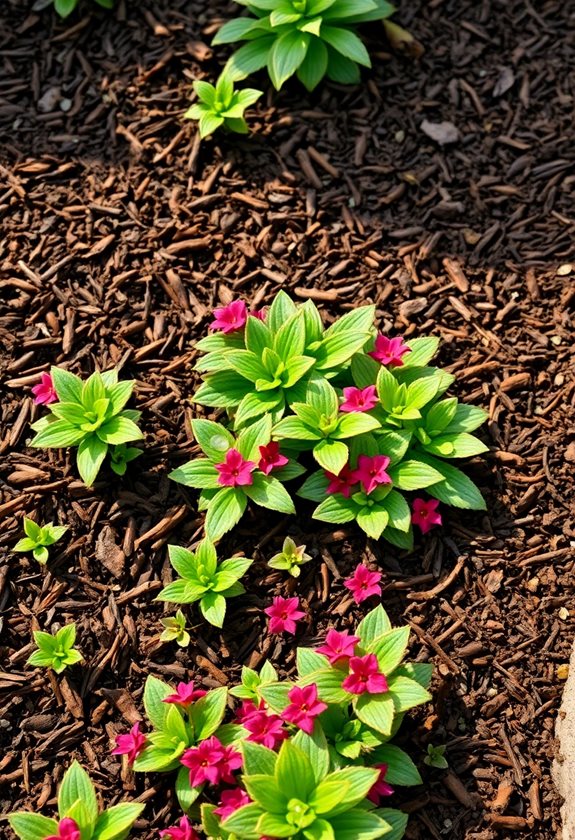
While you might think of mulch as just a decorative layer on your garden beds, it plays an essential role in moisture retention and helping your plants thrive. By using organic mulches like wood chips or straw, you not only suppress weeds but also enrich your soil as they decompose. Ground covers, like clover or creeping thyme, can act as living mulch, preventing evaporation and adding beauty! So, why not give them a try? Add 2-3 inches of mulch around your plants, and watch them flourish! Remember, happy plants mean a happy gardener! Isn’t that what we all want? Additionally, incorporating essential water feature care tips can enhance the overall health of your garden by ensuring proper hydration levels.
Frequently Asked Questions
How Often Should I Water My Garden Plants?
You should water your garden plants about once a week, but it depends on their needs! Feel the soil; if it’s dry an inch deep, it’s time to hydrate. Early mornings work best since cooler temps reduce evaporation. Consider these tips:
- Water deeply for strong roots.
- Adjust for rain—nature’s got your back!
- Don’t forget containers; they dry out fast!
How often do you water? Finding that balance can be a fun challenge!
What Time of Day Is Best for Watering?
You’ll find the best time to water your garden is early morning, before the sun gets blazing! Why? It allows plants to absorb moisture without losing it to evaporation. Plus, watering in the evening can leave leaves wet overnight, inviting pests. Aim for around 6 to 9 AM. Got a busy schedule? Set an alarm! Your plants will thank you as they soak up that revitalizing drink, thriving and blooming beautifully! Isn’t gardening rewarding?
Can I Use Greywater for My Garden?
Absolutely, you can use greywater in your garden! It’s a fantastic way to recycle water, but make sure you’re cautious. Use only safe soaps and avoid chemicals that could harm plants. Here are a few tips:
- Set up a simple collection system.
- Direct it to your garden beds, not edible crops.
- Water early in the morning for the best absorption.
Isn’t it great to think you’re helping the environment while gardening? Happy planting!
How Do I Check Soil Moisture Levels?
Checking soil moisture levels is super important for your garden’s health! You can use a simple method: stick your finger about an inch into the soil. If it feels dry, it’s time to water! You could also invest in a moisture meter for precision. Remember, overwatering can be just as harmful as underwatering. So, what’s your soil telling you today? Plunge into it, and let your garden flourish with the right care! Happy gardening!
What Are the Signs of Overwatering Plants?
You know you’ve overwatered your plants when their leaves turn yellow or start to drop—yikes! Also, check for wilting, despite wet soil. If you see mold or a funky smell from the soil, that’s a sure sign too. It’s like a plant’s way of saying, “Help, I can’t breathe!” To avoid this, always check the top inch of soil before watering. Trust me, your plants will thank you with vibrant growth!

